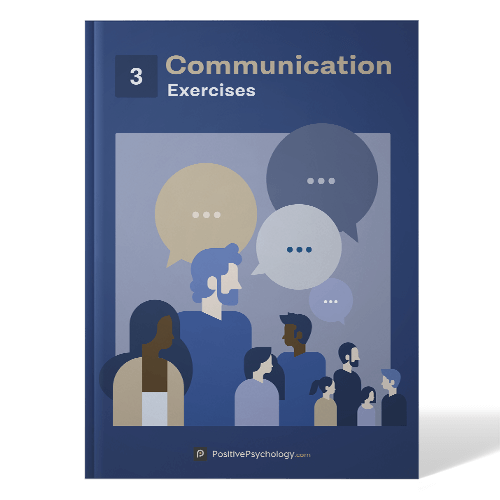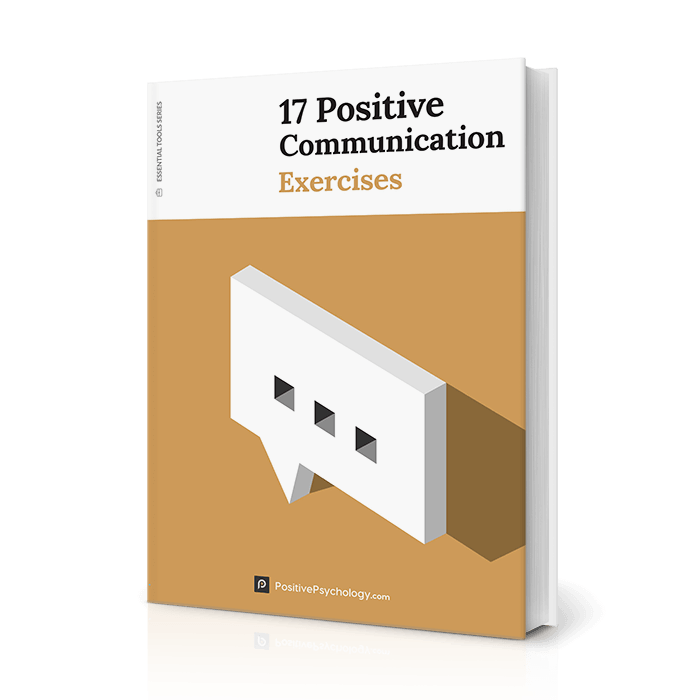10 Best Assertive Communication Worksheets and Techniques
 An assertive person makes a point clearly and calmly, with confidence.
An assertive person makes a point clearly and calmly, with confidence.
They accept that they may have more to learn and, therefore, fear neither challenge nor a difference in opinion.
They consider their own needs as necessary, and while coming across as assured, they are definitely not aggressive. While communicating, such an individual is both respectful to themselves and those with which they share thoughts and opinions.
Being assertive is a crucial aspect of effective communication and requires you to be heard but not aggressive. This article explores this balance and how it can be identified and developed through a series of worksheets and techniques.
Before you continue, we thought you might like to download our three Positive Communication Exercises (PDF) for free. These science-based tools will help you and those you work with build better social skills and better connect with others.
This Article Contains:
5 Worksheets and Workbooks
Assertive communication is a powerful tool that helps you to speak up and be heard. It is a way to say, “this is who I am, and this is how I want to be treated” while remaining aware of the feelings and needs of others (Murphy, 2011).
However, it is not about trying to be liked all the time. Nor is it concerned with making everyone else happy or keeping the peace.
The aim of assertiveness is to make sure that you are heard and treated fairly.
Not only does assertiveness enhance communication skills and strengthen decision making, but it also improves your self-esteem.
Becoming more assertive will make you better equipped to face conflict and difficult situations without self-doubt while earning others’ respect.
So how do you or your clients become more assertive?
Building a healthy self-perception
It can be useful to create a set of assertiveness rules by which you can live. They should remind us that we have the right to individual needs and can expect them without guilt or doubt (Smith, 1985).
Have a look at the Rights of Assertiveness worksheet.
Regularly review the assertiveness rules, amending them as needed. They can be especially useful before or after difficult conversations to bolster internal strength and remind you that you deserve respect.
Indeed, while good manners are important, they can lead to a restrictive mindset. We don’t have to say yes to everything, and it is fine to disagree with what is said.
Self-talk for assertiveness
Self-talk can be positive or negative. Indeed, telling ourselves we can’t do something damages our self-belief and can reduce feelings of self-respect.
On the other hand, athletes using positive motivational self-talk can push their limits for longer and even increase their capacity to cope with pain (Meijen, 2019).
Use this Positive Assertiveness Statements worksheet to encourage a robust and healthy degree of self-worth.
Repeating the statements daily and before difficult conversations can change your perception and improve self-confidence. Feel this shift in how you view yourself, strengthening your inner voice and becoming aware of the increased self-empowerment.
Assertive talk
When talking assertively, it is vital to consider what others hear.
If you mumble or don’t speak clearly, you will sound like you lack confidence and passion.
The Talk Assertively worksheet contains four techniques to encourage verbal assertiveness.
It can be useful to play back earlier communications to see how they could have been improved by employing these communication techniques more consistently.
Find opportunities to practice the four approaches and make improvements based on lessons learned.
Planning what you are talking about
Knowing your subject matter and being clear on what you wish to share will help your confidence and make you sound more assertive.
Chris Anderson (2017), creator of the successful TED Talks, writes that every good communication starts with having ”something meaningful to say, and your goal is to re-create your core idea inside your audience’s minds.”
To do this, you must:
- Focus on one key idea
- Find a reason for people to care
- Build the idea out of concepts the audience already understands
After all, successful communication means you have something worth saying.
Try out the Communicating an Idea Effectively worksheet for steps on how to successfully present that idea.
Assertiveness obstacles
We often create our own obstacles to being assertive.
Identifying the challenges and finding ways to overcome them will help us grow and get closer to reaching our goal of being a more assertive person (Banks, 2020).
Try out the Assertiveness Obstacles worksheet.
Ask yourself if any of the left-hand column statements are correct (I don’t know what I want; My needs don’t matter; etc.). If you think these are valid, consider the right-hand column’s actions and focus your attention on removing the obstacle between you and becoming more assertive.
Helpful Techniques and Tips
If you wish to overcome assertiveness obstacles, then we have a few handy tips and techniques you can try out.
Assertiveness and aggression

Aggressive people do not respect the views or the needs of others. They often raise their voices, trample on the opinions of others, and invade their personal space. Their sarcasm and shouting can even lead to violence.
Assertiveness is dignified. Those who are skilled walk the fine line between getting what they want and stepping on others’ needs.
Read our related article on Nonviolent Communication.
Assertiveness and passivity
Being passive can be as unhelpful to communication as aggression (Murphy, 2011).
The difference between the two is, again, one of respect.
After all, passive people lack respect for their own feelings, needs, and opinions. The desires of others become more important than their own.
Being aggressive will not win you many friends, but neither will passivity. It is ultimately a loss of power, allowing others to make the decisions on our behalf.
How do I stop myself or my client from being a captive of the environment and become assertive?
Visualize success in assertive communication
Use the earlier guidance to help visualize a successful and assertive conversation where everything goes well. The more real you can make it – sights, sounds, smells – the greater the positive impact will be.
Also, consider revisiting previous situations that went well and spend time feeling good about how you performed.
Feel confident in returning to less successful conversations. Where it felt like it went wrong, change how you reacted and how secure you felt.
Picture how strong you can be.
Develop assertive body language
While we have so far focused on internal assertiveness, it is worth considering the impact of our behavior.
In Presence: Bringing Your Boldest Self to Your Biggest Challenges, Harvard professor Amy Cuddy (2018) says we change the impression we make on ourselves (and others) by adopting behaviors that reflect both strength and power.
She describes presence as confidence without arrogance. According to a large body of research, it can be achieved through “self-nudges, small tweaks in our body language and mindset.”
Try out Cuddy’s “power pose.”
Adopt a confident stance, with hands on hips like Wonder Woman or Superman, and hold for two minutes.
There are other ways to develop strong body language:
- Strong eye contact
- An honest, genuine smile
- Shoulders back but relaxed
- When sitting, be straight and tall
- Gesture with your hands comfortably but not frequently (relax them at your sides when they are not needed)
A video demonstrating the power pose is shared in the TED Talk section below.
Personal relationships
Personal relationships can be challenging for people lacking in assertiveness. If you wish to be respected by friends and partners, you must first respect yourself.
Judy Murphy (2011) offers the following tips for being assertive in a relationship:
- Take back the power.
If you are sharing a home, remind yourself that you deserve it to be comfortable.
No one has the right to make me uncomfortable in my own home.
- Determine what you want.
Take time to think about what you want from a successful relationship and what changes you would like.
Express your wants and needs calmly yet confidently.
If you don’t communicate your needs, you are not being fair to yourself or your partner.
- Communicate what you want.
Make time to talk with your partner. Share your needs and listen to theirs.
Use “I” and “me” when discussing what you are looking for in a relationship.
- Continue to be caring.
Being assertive does not mean you should be uncaring.
The fact that you wish to share your feelings and improve your relationship should be a sign that you want to invest more in the bond you have together.
Find time together to share your needs calmly.
It doesn’t have to be a stressful occasion but rather an opportunity to grow the relationship to fulfill you both.
Assertiveness at work
Assertiveness in the work environment is crucial. When successful, you communicate your needs and wishes clearly (what is to be done, by when, and how) without appearing discourteous or rude.
While being assertive does not ensure you always get what you ask for, it does increase the likelihood of a positive outcome.
Respect (for yourself and others) and good relationship communication skills are crucial to assertiveness, but also:
- Be assertive but not aggressive.
You will not gain respect if you behave aggressively at work, which will hinder your ability to communicate effectively. - Prepare.
Visualize, note down, or discuss with someone you trust how you are going to manage a problematic conversation assertively. - Know your rights.
Take time to learn about what you are entitled to and what is acceptable.
For example, what are you entitled to in terms of vacation time and sick leave? Are there any limitations on when it can be taken? If a manager is behaving inappropriately, what are your next steps?
- Know your boundaries.
What are your limits when it comes to how many hours you work? While you may accept some late work, at what point does this become unacceptable? - Recognize how valuable you are.
Value yourself as a person and an employee. Consider your strengths at work and what you bring to the organization.
5 Activities and Exercises
To be more assertive, you or your client may need to form some new habits (Banks, 2020).
While it can be challenging to make many changes at once, it can be more comfortable taking one at a time.
Consider the following:
- Be clear about your vision.
What do you want to accomplish? Create a long-term vision. - Set goals.
Create shorter term SMART goals that will help you reach your longer term vision. - Practice positive thinking and visualization.
Consider who you would like to be and how you would like to communicate. Creating a strong positive image can reframe how you see yourself, building both self-confidence and self-respect. - Challenge yourself.
Growth and confidence can be built by meeting and overcoming challenges and obstacles. - Focus on your strengths.
Understand your strengths and use them.
Assessment Methods: Questionnaire

For example, if you view yourself negatively, you will find it difficult to ask (or be asked) a direct question. Sharing your opinion takes confidence.
Evaluating yourself
It’s essential to understand how you see yourself. What beliefs do you hold?
Answer the questions on the Self-Evaluation for Assertiveness worksheet to gain insight into how your perception of yourself affects how you communicate.
The number of negative answers to questions such as “Are you able to say no?” indicates how assertive you are.
Lacking assertiveness is a problem. Without it, you tend to back down and live your life on other people’s terms rather than your own.
Assertiveness in Children: 3 Games
Teaching children to be assertive can help improve their respect for themselves and others while reducing the likelihood of being bullied or placed in awkward situations by peers.
Communication games and role-playing can be safe and effective ways for children to develop self-confidence and build assertiveness.
Standing up for yourself
Use dolls or soft toys to play out a situation where one child tries to take something from another forcibly.
Talk to the child about how sharing doesn’t mean you have to give away what you are playing with instantly.
Work with them to come up with a list of ways they can stand up for themselves assertively, but not aggressively.
Meeting new people
Using dolls or puppets, role-play with a child (or group of children) about how they might introduce themselves and ask if they can play with others.
Practice being the new child, but also part of an established group of friends.
Making mistakes
Children must learn how to handle situations when they make mistakes. Not only can such problems be stressful, but they can also damage their confidence.
Use toys or dolls to enact and discuss situations when things go wrong. Discuss how to be honest about what happened (a broken vase or being unable to perform a task), and if appropriate, apologize or stop something from happening in the future.
3 Interesting TED Talks
Take a few minutes to listen to these inspiring TED Talks.
1. 10 ways to have a better conversation – Celeste Headlee
Based on many years as a radio host, Celeste Headlee provides 10 powerful rules to have better conversations. Even adopting one or two will hugely improve your ability to become a better communicator.
“Go out, talk to people, listen to people,” she says. “And, most importantly, be prepared to be amazed.”
2. How to speak so that people want to listen – Julian Treasure
As a sound consultant, Julian Treasure has listened to his fair share of good and bad communication.
In his fascinating talk, Treasure lists the bad habits that make us tune out, alongside what we can do to draw people in when we speak. Crucially, he offers some valuable tips on improving our voice’s quality and fully engaging with our listeners.
3. Your body language may shape who you are – Amy Cuddy
In 2012, Amy Cuddy rose to fame with her talk – the second most popular ever – on the potential of posture to boost feelings of power.
Cuddy suggested that the “power pose” can transform us into confident and assertive individuals who perform better in interviews and other challenging environments.
While Cuddy and team have since received criticism, they came back with further proof to back up their claims. If you have two minutes before your next big presentation, it’s worth a try.
Books on the Topic
The best way to learn even more about assertiveness is to immerse yourself in a good book. We share a few suggestions below.
1. Assertiveness: How to Stand Up for Yourself and Still Win the Respect of Others – Judy Murphy
This book covers every aspect of assertiveness from self-evaluation to growth and making it a habit.
It explores the differences between assertiveness, aggression, and passivity and how to define a bill of rights for the former.
The guidance is incredibly insightful for understanding assertiveness in multiple contexts, including parenting, relationships, and the workplace.
Find the book on Amazon.
2. Presence: Bringing Your Boldest Self to Your Biggest Challenges – Amy Cuddy
Following Amy Cuddy’s epic success with her TED Talk about “power poses,” she presents exciting research regarding other body–mind effects.
In her book, she shares several simple techniques to handle high-pressure moments and feel more assertive and confident.
Find the book on Amazon.
3. Executive Presence: The Missing Link Between Merit and Success – Sylvia Ann Hewlett
Whether you plan to step up into a leadership role or not, Sylvia Ann Hewlett’s book provides fascinating insights into workplace power and influence.
She introduces the results of research across multiple sectors into executive presence and then explains how to move from working like an executive to feeling like one.
Find the book on Amazon.
PositivePsychology.com Tools
Knowing and using your strengths can be an effective way to improve confidence and become more assertive.
We have many resources at PositivePsychology.com that will help you or your client build your strengths.
- General Strength Cards – Use the cards provided to understand your strengths and celebrate your positive qualities.
- How To Use Your Signature Strengths – Learn how to leverage your strengths in different ways and contexts.
- Exploring Character Strengths – Identify and reflect on your character strengths.
Finally, the Maximizing Strengths Masterclass© is the ultimate tool in helping yourself and others identify and develop their strengths. This coaching package is just what you need to become a strengths-based practitioner and help clients reach their full potential.
If you’re looking for more science-based ways to help others communicate better, this collection contains 17 validated positive communication tools for practitioners. Use them to help others improve their communication skills and form deeper and more positive relationships.
A Take-Home Message
Being assertive is not about railroading people into taking on board your views or doing things they don’t want to do – it’s about being heard.
Assertiveness requires confidence – often quiet confidence – that owes as much to respecting yourself as others. You may not want to climb the corporate ladder, but you also don’t want to be ignored when you have something to say.
After all, don’t we all want to be valued?
Think about your mindset, how you speak, what you have to say, and even how you behave to adopt a more assertive style. The change will be apparent in how you feel and how others see you.
Use the tools and techniques yourself, or with clients, to feel a sense of worth and communicate authentically, displaying assurance rather than passivity or aggression.
We hope you enjoyed reading this article. Don’t forget to download our three Positive Communication Exercises (PDF) for free.
- Anderson, C. (2017). TED talks. Headline Book Publishing.
- Banks, R. (2020). The keys to being brilliantly confident and more assertive: A vital guide to enhancing your communication skills, getting rid of anxiety, and building assertiveness. Author.
- Cuddy, A. J. (2018). Presence: Bringing your boldest self to your biggest challenges. Little, Brown Spark.
- Hewlett, S. A. (2014). Executive presence: The missing link between merit and success. Harper Business.
- Meijen, C. (2019). Endurance performance in sport: Psychological theory and interventions. Routledge.
- Murphy, J. (2011). Assertiveness: How to stand up for yourself and still win the respect of others. Author.
- Smith, M. (1985). When I say no, I feel guilty. Bantam.
Let us know your thoughts
Read other articles by their category
- Body & Brain (50)
- Coaching & Application (57)
- Compassion (26)
- Counseling (51)
- Emotional Intelligence (24)
- Gratitude (18)
- Grief & Bereavement (21)
- Happiness & SWB (40)
- Meaning & Values (26)
- Meditation (20)
- Mindfulness (45)
- Motivation & Goals (45)
- Optimism & Mindset (34)
- Positive CBT (29)
- Positive Communication (20)
- Positive Education (47)
- Positive Emotions (33)
- Positive Leadership (18)
- Positive Parenting (4)
- Positive Psychology (33)
- Positive Workplace (37)
- Productivity (17)
- Relationships (46)
- Resilience & Coping (38)
- Self Awareness (21)
- Self Esteem (38)
- Strengths & Virtues (32)
- Stress & Burnout Prevention (34)
- Theory & Books (46)
- Therapy Exercises (37)
- Types of Therapy (64)









What our readers think
very interesting. And helpful tools.